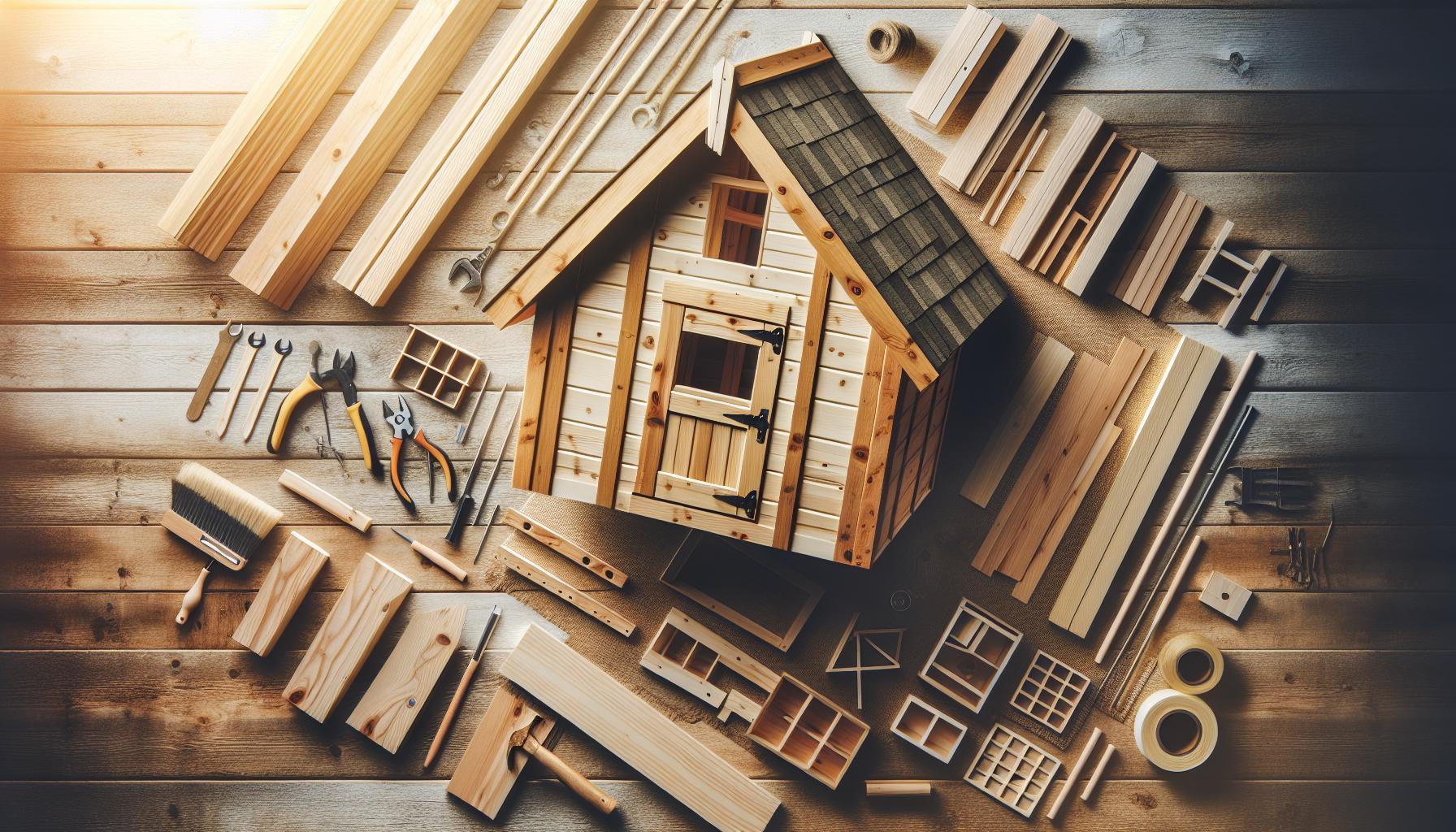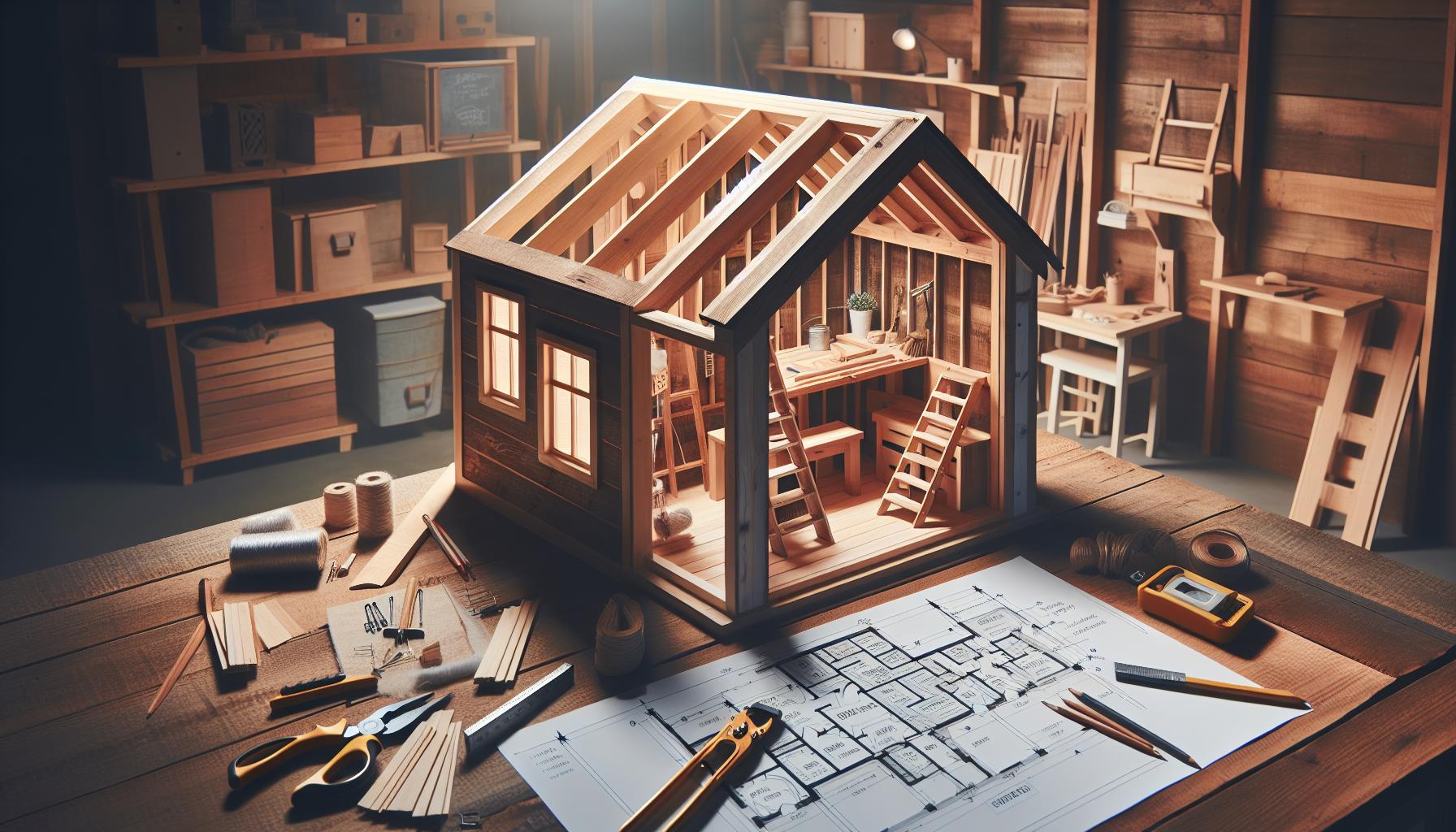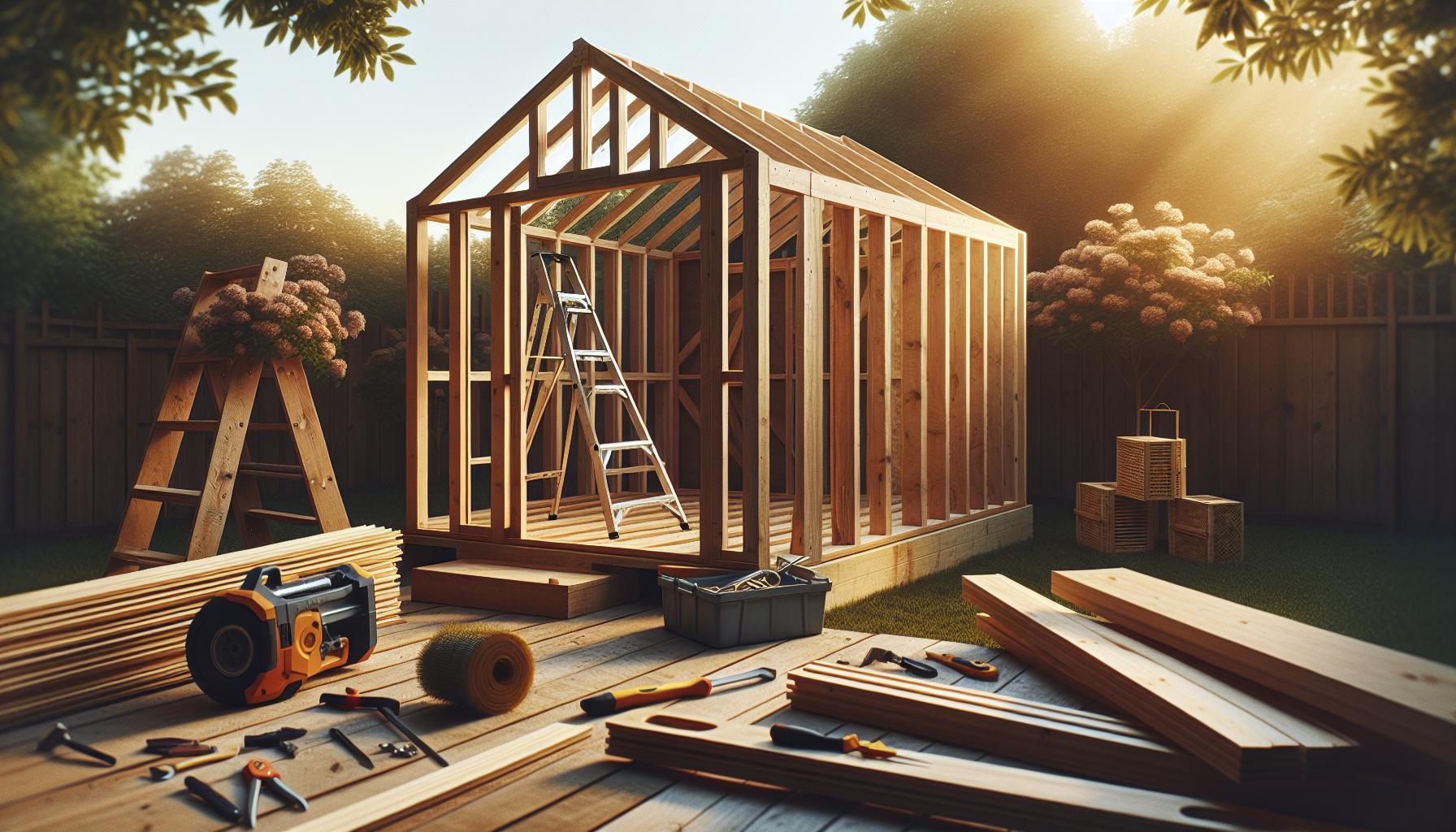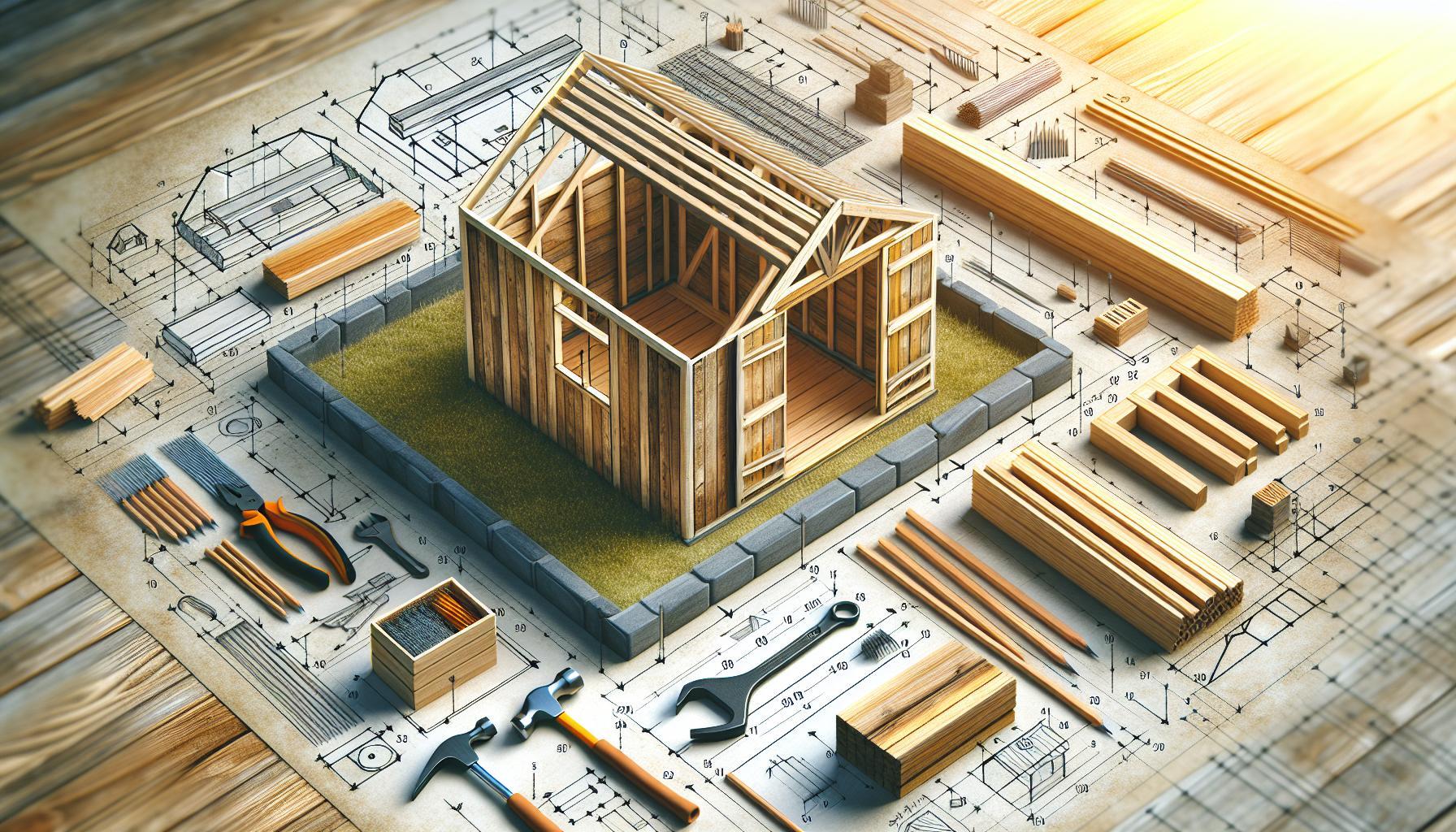Maximizing storage space in your backyard can be a challenge,especially when you’re short on room. Constructing a shed with an elevated loft offers a smart and creative solution, allowing you to store seasonal items and equipment out of the way. This guide will walk you through the essential steps to build an efficient lofted shed, enhancing your outdoor association and utility.
Understanding the Benefits of a Lofted Shed
Building a structure that maximizes space is crucial for anyone looking to increase their storage capabilities. A lofted shed, specifically designed to take advantage of vertical space, offers a multitude of benefits that can transform how you use your outdoor areas. By adding a loft, you effectively *double your storage space vertically*, allowing for better organization, improved accessibility, and less clutter around your property.
One of the key advantages of a lofted shed is its ability to accommodate larger and more cumbersome items without sacrificing ground space. Traditional sheds can fill up quickly, often leaving homeowners scrambling to find new places to store tools, outdoor equipment, or seasonal decorations. With a loft, you can store bulky items like bikes or fishing gear on the lower level while utilizing the overhead space for less frequently used items, such as holiday decorations or camping supplies. This organization promotes efficient usage of the entire shed, reducing the time and effort spent searching for items.
Functional Versatility
The lofted design isn’t just about storage; it also opens the door to numerous functional possibilities. These sheds can serve as workshops, art studios, or even playrooms. For instance, if you’re a hobbyist, the loft can provide the perfect spot for crafting materials, while the main area can be dedicated to workspace. This flexibility allows homeowners to tailor their shed to suit their unique needs, making it an invaluable addition to any property.
Increased Property Value
Investing in a lofted shed can also elevate your property value. Prospective buyers often appreciate functional and well-organized outdoor spaces. A well-designed shed that showcases clever storage solutions will be more appealing, highlighting the potential for utility and backyard enhancement. Incorporating features like custom shelving or finished loft areas can further enhance its aesthetic and functional appeal.
understanding how to effectively build a shed with a loft can transform your storage solutions while adding critically important value to your property. By embracing vertical space, you not only organize your belongings but also unlock new functionality and versatility, making the most of your outdoor environment. As you plan your lofted shed construction, consider layout options and the specific needs of your household to maximize the benefits it can offer.
Essential Planning: Designing Your Loft and Shed Layout
Planning the design of your shed with a loft can be a game changer for maximizing storage space and functionality. By utilizing vertical space, you can effectively double your storage capacity, making your shed not just a simple storage unit, but a versatile area that can enhance your outdoor activities. Before diving into construction, it’s vital to spend ample time conceptualizing the layout and purpose of both the shed and the loft.
Start by assessing your needs and the overall purpose of the shed. Will it primarily serve as a tool storage area, a hobby space, or perhaps a combination of both? Identifying the specific items you plan to store will guide your design decisions. As a notable example, if you intend to keep larger tools or equipment on the lower level, ensure the loft is designed to accommodate lighter items such as seasonal decorations or smaller storage bins. This careful planning prevents overcrowding in either area and maintains ease of access.
Key Considerations for Loft Design
When designing the loft, consider the following elements to ensure safety and functionality:
- Height and Accessibility: Determine the appropriate height for the loft. Ensure that you have enough vertical clearance to comfortably stand on the lower level.
- Load Capacity: Factor in the weight of items you plan to store. Use the right materials for floor joists to avoid issues; for instance,using 2×8 lumber spaced 24″ apart for spans.
- Access Points: Decide how you will access your loft. A simple ladder can save space,while a foldable stairway might offer safer and easier access.
Adding a
| material Type | Span (in feet) | Joist Size |
|---|---|---|
| 2×6 Lumber | 10 | 16″ on center |
| 2×8 Lumber | 12 | 24″ on center |
Incorporating these considerations during the planning phase will lead to a well-structured and efficient loft that enhances the overall utility of your shed. As you embark on your project, remember that thoughtful design is key to creating a functional and appealing space, making the journey of learning how to build a shed with a loft a rewarding experience.
Choosing the Right Materials for Durability and Aesthetics
When embarking on a project that involves maximizing vertical space, such as constructing a shed with a loft, the choice of materials is paramount. Not only do these materials need to provide the structure’s strength and durability, but they also contribute significantly to the overall aesthetics of your shed. The right combination can definitely help ensure your storage solution is both functional and visually appealing, enhancing your property’s value and curb appeal.
Material Options for durability
Selecting materials for your lofted shed often boils down to three primary options: wood, metal, and resin.Each has unique properties that cater to different needs and preferences.
- Wood: Traditionally favored for its aesthetic appeal and ease of customization, wooden sheds can be tailored to fit any design preference. However, they require regular maintenance, such as staining and sealing, to protect against rot and pests.
- Metal: Known for its strength and durability, metal sheds withstand the elements well and often have longer lifespans compared to wood. They are resistant to pests and doesn’t warp like wood, but can be prone to rust if not properly coated.
- Resin: Offering a blend of durability and low maintenance, resin sheds are impervious to rot, rust, and pests. they are lightweight and frequently enough cheaper, but they may not offer the aesthetic value that wood or metal can provide.
Balancing Aesthetics and Functionality
The look of your shed can significantly influence your outdoor space, so it’s wise to consider how each material complements your home and garden. For example, wooden sheds can be painted or stained to match the color scheme of your home, creating a cohesive look. Conversely, resin sheds come in various colors but typically have a more utilitarian appearance, while metal sheds can be sleek and modern but may lack warmth.
To assist with your decision, here is a swift comparison table of the common materials for sheds:
| material | Durability | Maintenance | Aesthetic Appeal |
|---|---|---|---|
| Wood | High | Moderate | High |
| Metal | Very High | Low | Moderate |
| Resin | High | Very Low | Low |
when considering how to build a shed with a loft and double your storage vertically, remember that the materials you choose play a critical role in defining the longevity and appearance of your new space. Weigh the pros and cons of each material against your specific needs and preferences to create a shed that not only meets your storage requirements but also enhances the beauty of your property.
Step-by-Step Guide to Constructing Your Shed Frame
Constructing a robust and reliable frame is essential for any shed, especially when integrating a loft to maximize vertical storage. A solid frame will not only support the walls and roof but also the additional weight from your loft and its contents. Begin by gathering your materials; common choices include treated lumber, which offers durability and resistance to moisture.
Gathering Materials
- 2×4 or 2×6 lumber for the main structure
- Plywood for wall sheathing and loft flooring
- Construction screws and nails for assembly
- Metal brackets for additional support
Next, ensure you have the right tools for the job: a circular saw, drill, level, and measuring tape will be indispensable in this process. When laying out your frame, carefully measure and mark the positions for your walls based on your design. start with a rectangular base, using sturdy lumber for the bottom framing to create a level foundation that will hold the structure evenly.
Building the Base and Walls
Construct the base by securing the perimeter boards together using straight and diagonal bracing to prevent any wobbling. Once your base is stable, move on to the vertical wall frames. Cut your studs to the desired height of your shed, and attach them every 16 inches on center for standard framing. Use a level to ensure that each stud is plumb. Secure each wall frame with a sufficient number of screws or nails, and don’t forget to introduce additional support for where the loft will sit.Lastly, install the loft structure by building it as a separate frame that can be attached to the main frame.This will require additional joists and a sturdy platform. You can choose to create a partial loft that only spans part of the shed or a full loft that takes up the entire width, depending on your storage needs. By ensuring that the loft is properly secured to both the wall studs and the main frame, you can safely store items above while keeping the ground space clear.
By following these detailed steps, you’ll build a strong, functional frame that supports both your shed’s basic structure and the loft above, maximizing your storage capacity effectively. This method of construction not only enhances the utility of your shed but also increases its overall durability and lifespan.
Constructing the Loft: Support Structures and Safety Tips
Creating a loft within a shed is an excellent way to maximize your storage space while maintaining a tidy and organized environment. A well-constructed loft can help you efficiently utilize vertical space, keeping your belongings accessible and out of the way. However, to ensure that this added storage is safe and structurally sound, careful consideration must be given to the support structures and safety measures during construction.
Support Structures for Your Loft
When planning the support for your loft, it is crucial to choose materials that can bear the anticipated load. Typically, 2×6 or 2×8 lumber is used for the floor joists, depending on the width of the shed and the weight of the items you intend to store. Install these joists at regular intervals, commonly 16 inches apart, to provide adequate support. Additionally,ensure that your framing is securely attached to the walls of the shed,using braces to prevent swaying and movement over time. Here are some types of support structures you might consider:
- Main Beams: Positioned perpendicular to the joists, these carry the majority of the load.
- Joists: Horizontal supports that create the loft floor.
- Bracing: Diagonal supports to enhance stability and prevent structural failure.
To further enhance safety, installing a railing around the loft’s perimeter is advisable. This prevents accidental falls and provides a secure edge when moving items in and out of the loft area.
Safety Tips for Building Your Loft
Prioritizing safety while constructing your loft is essential,not only for the integrity of the structure but also for the wellbeing of anyone using it. Here are some key safety tips to follow:
- Load Limit Awareness: be aware of the weight capacity of your loft. Overloading can lead to structural failure.
- Fire Safety Measures: Ensure that materials used are flame-resistant, particularly if you store combustible items.
- Ventilation: Proper airflow in the loft helps prevent moisture buildup,which can lead to mold and decay.
- Access & Egress: Design a safe and sturdy stairway or ladder for easy access to the loft. Avoid makeshift solutions that could compromise safety.
Incorporating these support structures and safety tips into your shed design not only aids in building a loft that effectively doubles your storage vertically but also ensures it remains safe and durable for years to come. By planning carefully and using the right materials, you’re setting yourself up for success in your project—a vital step in learning how to build a shed with a loft effectively.
insulating and Finishing Your loft Space for Versatility
When considering how to maximize your storage space vertically, insulating and finishing your loft area can turn it into a useful and cozy extension of your shed. Proper insulation not only helps maintain temperature but also ensures the structural integrity and longevity of the materials you use, making your shed more versatile for various uses, whether it’s a workshop, hobby area, or storage for seasonal items.
Choosing the Right Insulation
When insulating your loft, the choice of materials is crucial.Common options include:
- Fiberglass batts: These are cost-effective and easy to install, great for DIY projects.
- Spray foam: Offers a superior insulation value in less space, but can be more expensive.
- Rigid foam boards: These are suitable for areas where space is at a premium and provide excellent thermal protection.
Each material has its own advantages and installation requirements,so select one that aligns with your budget and intended use.As an example, if you’re finishing the loft as a bedroom or a workspace, opt for a more effective insulating solution like spray foam to keep consistent temperatures year-round.
Finishing Touches for Functionality
Once insulated, the next step is to finish the space to enhance usability. This includes adding a floor if it’s not already there, which allows for better access and storage options. consider using materials like plywood for flooring, which can easily support weight and creates a sturdy base for shelving or storage boxes.
In addition, ensure that there is adequate ventilation in your loft to prevent moisture buildup, which can lead to mold. Incorporate vents or a small window to enhance airflow. Furthermore, installing proper lighting—such as LED strips or battery-operated lights—can transform the loft into a functional area even during the darkest months.
Creating Storage Solutions
To truly double your storage vertically while building a shed with a loft, think creatively about shelving and organizational systems. vertical storage can be achieved through various solutions, such as:
- Wall-mounted shelves: Utilize the walls for additional storage without compromising floor space.
- Storage bins: Label and stack bins to categorize items while maximizing space.
- Hanging storage: Use hooks and pegboards to keep tools and smaller items off the floor.
Incorporating these elements into your loft design not only enhances the efficiency of your storage but also makes the loft adaptable for various uses in the future.
Investing time and effort into properly insulating and finishing your loft will yield significant returns, providing a versatile, comfortable space that meets your storage and functional needs perfectly.
Maximizing Storage: Smart Organization Strategies for Your Shed
To truly tap into the potential of your shed and create a tidy, functional space, smart organizational strategies are essential. By maximizing vertical space and properly categorizing your items, you can not only create more room but also make it easier to find what you need. From the outset, consider what types of items will be stored in this multifunctional space. Gardening tools, outdoor equipment, and seasonal decorations are common shed inhabitants, each requiring distinct storage methods to optimize accessibility and efficiency.
Utilizing Vertical Space Effectively
One of the primary advantages of building a shed with a loft, as discussed in the concept of doubling storage vertically, is the ability to store items at varying heights.Use the loft area to keep less frequently used items, such as holiday decorations or larger tools, while keeping commonly used tools and supplies within reach.Here are a few effective strategies:
- wall-mounted Racks: Install bicycle hooks and pegboards on the walls to hold gardening tools, hoses, and other equipment that might or else take up floor space. Pegboards, in particular, allow for a customizable layout that can adapt as your storage needs change.
- Floating Shelves: Adding floating shelves above workbenches or in corners can make use of otherwise wasted space. This is perfect for smaller items like pots, paints, and other supplies.
- Clear Bin Storage: Consider using clear, labeled bins that can be stacked in the loft or on shelves.This allows you to quickly identify contents while keeping everything organized.
Strategic Zoning
Creating zones within your shed for specific activities can streamline your organization efforts. Allocate areas or sections for gardening, DIY projects, and maintenance tools. As an example, you might designate one side of the shed for garden supplies and another for woodworking tools. This zoning prevents clutter and makes it easy to return items to their rightful places. To visualize this, consider a table layout:
| Zone | Items |
|---|---|
| gardening | Shovels, Rakes, Seed packets |
| Woodworking | Saws, Hammers, Nails |
| Maintenance | Paint, Brushes, Cleaning supplies |
By grouping similar items together, you can reduce time spent searching for tools and supplies, enhancing the overall functionality of the shed.
Incorporating these organization strategies will not only help you maximize storage but also ensure your shed remains an effective workspace for all your needs. Implementing a combination of vertical storage solutions and strategic zoning will transform your shed into a well-organized hub of efficiency.
Maintenance Tips for Longevity: Keeping Your Lofted Shed in Top Shape
When you invest time and effort into creating a functional lofted shed,maintaining its integrity and appearance is vital to ensure it remains a reliable storage solution for years to come. Regular upkeep not only extends the life of your shed but also preserves its aesthetic appeal, providing a welcoming space that complements your home and garden.Here are some actionable maintenance tips to keep your lofted shed in top shape.
Regular Inspections
Conducting seasonal inspections is key to identifying potential issues before they escalate.look for signs of wear and tear,such as:
- roof Condition: Check for missing shingles or leaks,especially after heavy rain.
- Wall Stability: Look for cracks or signs of rot, particularly around areas that come into contact with moisture.
- Foundation Integrity: Ensure the shed is level and there are no signs of shifting or settling.
Keeping a maintenance log can help track the condition of different elements and remind you when it’s time for a thorough check.
Cleaning and Upkeep
Keeping the lofted shed clean is essential for preventing the buildup of debris and moisture. Schedule regular cleaning sessions:
- Gutters and Drainage: Clear out gutters and downspouts to ensure proper drainage and prevent water damage.
- Interior organization: Regularly rearranging and decluttering the interior can maintain functionality. Use shelves and hooks to maximize vertical space effectively.
- Surface Wash: Use mild detergent and water to wash the exterior surfaces, removing dirt, mildew, and other potential nuisances.
Protective Measures
To significantly enhance the longevity of your lofted shed, consider implementing protective measures:
- Wood Treatments: Apply a wood preservative to prevent rot and insect damage. This is crucial for the framing and any exposed wood surfaces.
- Sealing Gaps: Inspect and reseal any gaps or cracks in the siding or foundation to repel water and prevent pests.
- Paint and Stains: Refresh the paint or stain every few years to create a protective barrier against the elements.
By following these maintenance tips, you can enjoy a well-preserved lofted shed that continues to serve your storage needs efficiently. Proper upkeep not only extends the longevity of your structure but also enhances its overall performance and aesthetic, allowing you to maximize your investment in this versatile space.
FAQ
How to Build a Shed With a Loft: Double Your Storage vertically?
Building a shed with a loft maximizes storage space by utilizing vertical height. Start by planning the layout to include a loft area above your workspace, ensuring you have sturdy supports. Use quality materials to ensure safety and longevity.
When constructing the loft, consider factors such as weight distribution and clearance. It’s essential to reinforce the walls and choose a suitable ladder or stairs for access. By optimizing your shed’s design, you can create a functional area for seasonal items, tools, or even a quiet workspace.
What materials do I need to build a shed with a loft?
Essential materials include lumber, plywood, roofing, and flooring. Specifically, 2x4s for framing, sheets of plywood for the loft floor, and siding materials such as T1-11 or vinyl for the exterior are necessary.
Consider additional items like insulation and electrical materials if you plan to add power to your shed. You can find detailed lists and specific quantities in shed building guides that cater to different sizes and designs.
Can I add a loft to an existing shed?
Yes, adding a loft to an existing shed is quite feasible. You will need to assess the current structure’s strength to support the additional weight.
Begin by reinforcing the walls and roof if necessary, then design the loft to fit within the existing dimensions. Utilizing pre-existing beams can help save on costs and create a cohesive look with your original shed design. It’s a great way to enhance functionality without a complete rebuild.
How do I ensure my shed with a loft is safe and sturdy?
Ensure safety by using quality materials and proper weight support calculations. Each aspect of your loft, from the beams to the flooring, should meet safety standards.
regular checks for structural integrity are essential,especially if you store heavy items. Consult guidelines from local building codes, and consider reinforcing critical areas based on your loft’s intended use. for more detailed safety tips, check out this comprehensive guide on shed construction.
Why does a loft add value to my shed?
A loft can significantly increase the utility and market value of your shed. By providing additional storage space, it allows you to organize your items more efficiently.
Potential buyers often seek versatile spaces, making a loft an attractive feature. Additionally, it can enhance your overall design and functionality, appealing to both DIY enthusiasts and casual users alike.
What are the common challenges when building a loft in a shed?
Common challenges include limited headroom and insufficient structural support. Planning the height and position of the loft is crucial to avoid cramped spaces.
Additionally, balancing the load between the floor and loft can be tricky. Take your time when assessing the design and structure. Utilize online resources and forums to troubleshoot specific issues you may encounter during your build.
How can I finish the interior of my shed loft?
Finishing the interior can involve insulation, paneling, and flooring choices. Consider using drywall or plywood for walls and adding insulation for climate control, especially if storing delicate items.
Creating a polished look can enhance your shed’s usability. Options for flooring vary; plywood is cost-effective, while laminate provides a more finished appearance. Personalizing your loft can make it a multifunctional space for hobbies or work.
Key Takeaways
building a shed with a loft is an excellent way to maximize storage while adding functional and aesthetic value to your outdoor space. By carefully planning your design, selecting quality materials, and following step-by-step construction techniques, you can create a sturdy structure that meets your storage needs without sacrificing style. Remember to pay attention to details such as ventilation and access to the loft for ease of use. Embrace the process, learn from any challenges that arise, and celebrate your craftsmanship.For more tips,resources,and inspiration,continue exploring our articles and connect with fellow DIY enthusiasts who share your passion for building! Happy shedding!







